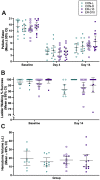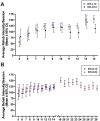Early, Intense Rehabilitation Fails to Improve Outcome After Intra-Striatal Hemorrhage in Rats
- PMID: 36384355
- PMCID: PMC9720710
- DOI: 10.1177/15459683221137342
Early, Intense Rehabilitation Fails to Improve Outcome After Intra-Striatal Hemorrhage in Rats
Abstract
Background: The formation and degradation of an intracerebral hemorrhage causes protracted cell death, and an extended window for intervention. Experimental studies find that rehabilitation mitigates late cell death, with accelerated hematoma clearance as a potential mechanism.
Objective: We assessed whether early, intense, enriched rehabilitation (ER, environmental enrichment and massed skills training) enhances functional benefit, reduces brain injury, and augments hematoma clearance.
Methods: In experiment 1, rats (n = 56) were randomized to intervention in the light (-L) or dark phase (-D) of their housing cycle, then to 10 days of ER or control (CON) treatment after collagenase-induced striatal intracerebral hemorrhage (ICH). ER rats were treated from 5 to 14 days after ICH. Behavior and residual hematoma volume was assessed on day 14. In experiment 2, rats (n = 72) were randomized to ER-D10, ER-D20, or CON-D. ER rats completed 10 or 20 days of training in the dark. Rats were euthanized on day 60 for histology. In both experiments, behavioral assessment was completed pre-ICH, pre-ER (day 4 post-ICH), and post-ER (experiment 1: days 13-14; experiment 2: days 16-17 and 30-31).
Results: Reaching intensity was high but similar between ER-D10 and ER-L10. Unlike previous work, rehabilitation did not alter skilled reaching or hematoma resolution. Varying ER duration also did not affect reaching success or lesion volume.
Conclusions: In contrast to others, and under these conditions, our findings show that striatal ICH was generally unresponsive to rehabilitation. This highlights the difficulty of replicating and extending published work, perhaps owing to small inter-study differences.
Keywords: enrichment; intracerebral hemorrhage; neuroprotection; rehabilitation; stroke.
Conflict of interest statement
The author(s) declared no potential conflicts of interest with respect to the research, authorship, and/or publication of this article.
Figures





References
Publication types
MeSH terms
LinkOut - more resources
Full Text Sources

